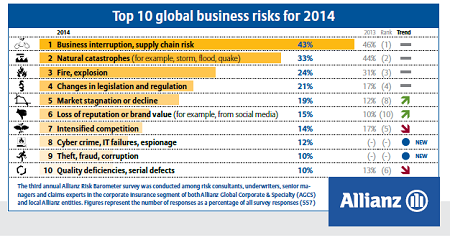Business interruption and supply chain risk, followed by natural catastrophes, are the most dangerous business risks facing American companies, according to the
Allianz Risk Barometer Survey 2014.
Fire and explosion came in at number three; loss of reputation or brand value ranked as the fourth highest risk and changes in legislation and regulation was at number five.
Globally, business interruption and supply chain risks, natural catastrophes and fire/explosion are the top three principal risks that continue to occupy the attention of global companies at the start of 2014.
The report found that the global risk landscape is becoming increasingly complex due to growing interdependency of different industries and processes. This, combined with the fact that inadequate internal processes are often the main factor behind companies suffering a crisis, means there is an increasing need for deployment of holistic, state-of-the art risk management and mitigation strategies.
The 2014 Risk Barometer also highlights that businesses are more concerned about cyber and reputational risks than ever before. According to Allianz experts, the most heightened risk awareness in 2014 is around cyber and loss of reputation issues. Cyber is the biggest global mover in this year’s Risk Barometer climbing up to rank eighth from 15, while reputation moved up to six from 10.

Talent shortages were also highlighted as a bigger risk in the Americas than in other markets, particularly in the insurance industry. Nearly 500,000 insurance professionals are retiring between 2008 and 2018, according to McKinsey; and the US industry alone will have to fill a gap of about 50,000 new hires a year – from claims to underwriting.
According to Allianz Global Corporate & Specialty’s Chief Executive for the Americas, Hugh Burgess, such a gap means investing in developing expertise is essential.
“New skills are needed – not the same as what were required 20 years ago,” he says.
“Different skillsets are necessary because new risks and challenges have arisen driven by factors such as increasing globalization; more competition; faster supply chains; “lean and just-in-time” manufacturing processes; digitalization; higher quality demands; greater regulation and compliance; increased complexity and inter-connectedness of risk; and advancements in risk modeling.”
Both ‘hard’ and ‘soft’ skills are needed, he says, classifying “hard” skills as “technical underwriting insight based on understanding of clients’ businesses; strong awareness of emerging perils such as environmental risks; insight into the client risk environment and new markets; and increasing specialization of knowledge, such as understanding of finance and engineering for BI risks”.


